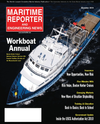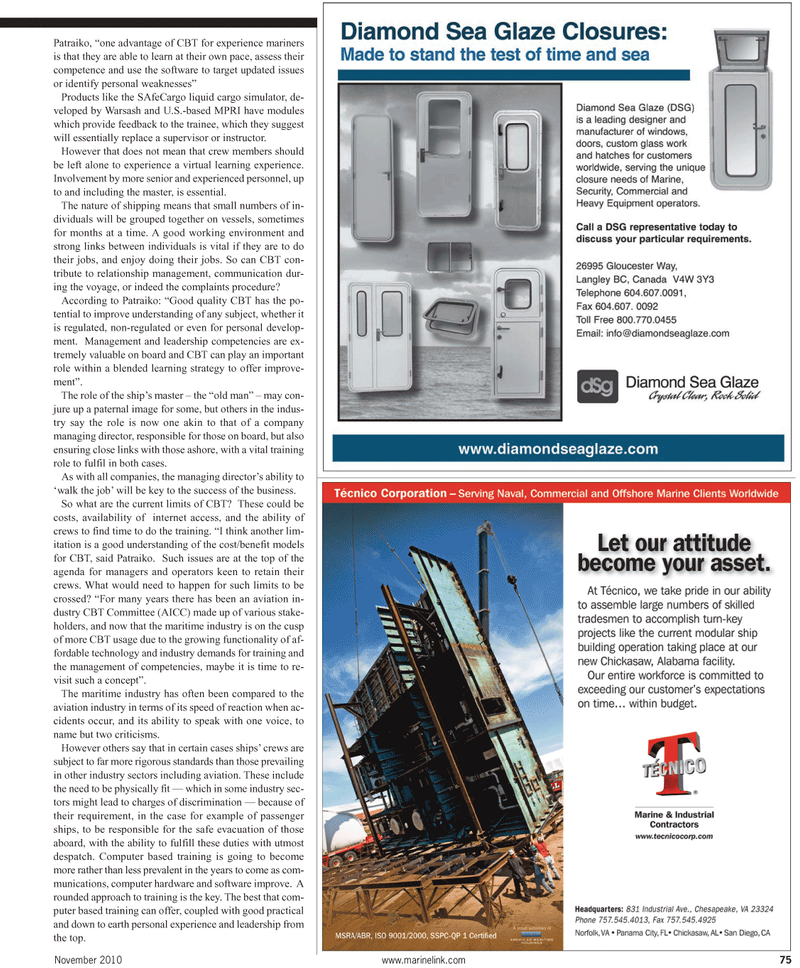
Page 77: of Maritime Reporter Magazine (November 2010)
Workboat Annual
Read this page in Pdf, Flash or Html5 edition of November 2010 Maritime Reporter Magazine
November 2010 www.marinelink.com 75
Patraiko, “one advantage of CBT for experience mariners is that they are able to learn at their own pace, assess their competence and use the software to target updated issues or identify personal weaknesses”
Products like the SAfeCargo liquid cargo simulator, de- veloped by Warsash and U.S.-based MPRI have modules which provide feedback to the trainee, which they suggest will essentially replace a supervisor or instructor.
However that does not mean that crew members should be left alone to experience a virtual learning experience.
Involvement by more senior and experienced personnel, up to and including the master, is essential.
The nature of shipping means that small numbers of in- dividuals will be grouped together on vessels, sometimes for months at a time. A good working environment and strong links between individuals is vital if they are to do their jobs, and enjoy doing their jobs. So can CBT con- tribute to relationship management, communication dur- ing the voyage, or indeed the complaints procedure?
According to Patraiko: “Good quality CBT has the po- tential to improve understanding of any subject, whether it is regulated, non-regulated or even for personal develop- ment. Management and leadership competencies are ex- tremely valuable on board and CBT can play an important role within a blended learning strategy to offer improve- ment”.
The role of the ship’s master – the “old man” – may con- jure up a paternal image for some, but others in the indus- try say the role is now one akin to that of a company managing director, responsible for those on board, but also ensuring close links with those ashore, with a vital training role to fulfil in both cases.
As with all companies, the managing director’s ability to ‘walk the job’ will be key to the success of the business.
So what are the current limits of CBT? These could be costs, availability of internet access, and the ability of crews to find time to do the training. “I think another lim- itation is a good understanding of the cost/benefit models for CBT, said Patraiko. Such issues are at the top of the agenda for managers and operators keen to retain their crews. What would need to happen for such limits to be crossed? “For many years there has been an aviation in- dustry CBT Committee (AICC) made up of various stake- holders, and now that the maritime industry is on the cusp of more CBT usage due to the growing functionality of af- fordable technology and industry demands for training and the management of competencies, maybe it is time to re- visit such a concept”.
The maritime industry has often been compared to the aviation industry in terms of its speed of reaction when ac- cidents occur, and its ability to speak with one voice, to name but two criticisms.
However others say that in certain cases ships’ crews are subject to far more rigorous standards than those prevailing in other industry sectors including aviation. These include the need to be physically fit — which in some industry sec- tors might lead to charges of discrimination — because of their requirement, in the case for example of passenger ships, to be responsible for the safe evacuation of those aboard, with the ability to fulfill these duties with utmost despatch. Computer based training is going to become more rather than less prevalent in the years to come as com- munications, computer hardware and software improve. A rounded approach to training is the key. The best that com- puter based training can offer, coupled with good practical and down to earth personal experience and leadership from the top.

 76
76

 78
78
